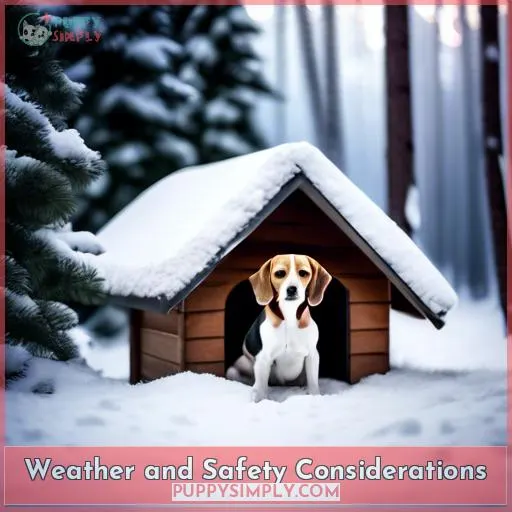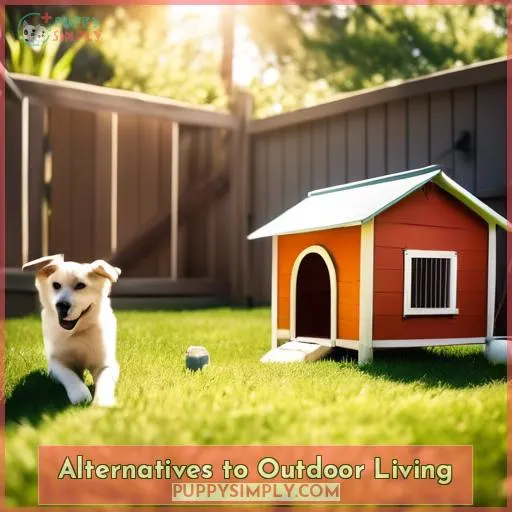This site is supported by our readers. We may earn a commission, at no cost to you, if you purchase through links.
 Nearly 20% of Beagles historically lived outdoors in packs, relying on each other for warmth and shelter. As a Beagle owner, you might wonder if your furry friend can thrive outside too.
Nearly 20% of Beagles historically lived outdoors in packs, relying on each other for warmth and shelter. As a Beagle owner, you might wonder if your furry friend can thrive outside too.
While Beagles enjoy outdoor activities, their need for companionship and safety from environmental hazards means living outside isn’t ideal.
This article will explore the nuances of outdoor living for Beagles, addressing their compatibility with the outdoors, temperament, and the potential risks involved.
Whether you’re considering letting your Beagle roam the yard or pondering full-time outdoor living, understanding these factors is crucial for their well-being.
Table Of Contents
- Key Takeaways
- Beagle Outdoor Compatibility
- Beagle Temperament and Outdoor Life
- Weather and Safety Considerations
- Potential Outdoor Hazards
- Alternatives to Outdoor Living
- Frequently Asked Questions (FAQs)
- How do Beagles typically respond to training for outdoor living adjustments?
- Can dietary changes help Beagles better adapt to outdoor temperatures?
- What are the specific signs of separation anxiety in Beagles left outdoors?
- How does the presence of other pets or animals in the yard affect a Beagle’s outdoor experience?
- Are there any breed-specific health concerns that can be exacerbated by living outdoors?
- Conclusion
Key Takeaways
- Beagles are sociable pets that thrive with human interaction and are best suited to living indoors with families.
- Secure outdoor environments are essential for outdoor living arrangements, but prolonged outdoor living can cause isolation and distress.
- Beagles historically worked in packs for hunting and were kept in covered kennels for protection and warmth when not hunting.
- Modern indoor preferences show that beagles have adapted to indoor living, value human companionship, and thrive on indoor exercise, enrichment activities, and socialization.
Beagle Outdoor Compatibility
Beagles, historically bred for hunting, have evolved into sociable pets that flourish with human interaction.
While they possess a robust nature and enjoy outdoor activities, their need for companionship means they’re best suited to living indoors with their families.
If you’re contemplating an outdoor living arrangement for your Beagle, it’s crucial to ensure they have a secure environment and aren’t left alone for extended periods.
Historical Outdoor Living
Beagles, originally bred for hunting due to their keen sense of smell and pack behavior, have a rich history of outdoor living. Historically, they worked in packs to track small game and were kept in covered kennels for protection and warmth when not hunting.
This outdoor lifestyle was essential for their role in hunting packs, where their ability to work together and communicate was paramount. The design of their kennels and the dynamics within the pack were crucial for their survival and efficiency as hunting dogs.
However, the breed has evolved significantly from its hunting origins. Modern Beagles have become indoor pets that thrive on human companionship. They still enjoy outdoor activities and require regular exercise for mental stimulation, but they aren’t suited to living outside full-time.
This shift from outdoor hunting packs to indoor family pets highlights the breed’s adaptability and the changes in human-animal relationships over time.
Key points regarding Beagles and outdoor living include:
- Historical Outdoor Living: Beagles were bred for hunting and often lived outdoors in packs, relying on each other for warmth and protection.
- Breed Evolution: Over time, Beagles have transitioned to being primarily indoor pets, valuing human interaction and companionship.
- Temperature Regulation: Their ability to tolerate a range of temperatures has implications for their care, especially in extreme weather conditions.
This evolution from outdoor hunting dogs to beloved indoor pets underscores the importance of understanding the breed’s needs for companionship, exercise, and safety. While they may have the physical capabilities to endure certain outdoor conditions, their psychological well-being is closely tied to being part of a family and engaging in activities that stimulate their hunting instincts and need for human interaction.
Modern Indoor Preferences
While Beagles historically lived outdoors in packs, modern Beagles have adapted to indoor living and are known for their need for human companionship.
They thrive on indoor exercise, enrichment activities, and socialization, which mitigate separation anxiety.
Outdoor games are vital, yet their indoor presence ensures safety from temperature extremes and potential hazards.
Beagle Temperament and Outdoor Life
Beagles are inherently social creatures that thrive on companionship, both with humans and other dogs. As pack animals, they form strong bonds with their families and require regular interaction to feel secure and content.
Therefore, it’s crucial for Beagles to have supervised outdoor time for exercise and play, rather than living outside alone, which could lead to feelings of isolation and stress.
Pack Animal Bonding
Having evolved as pack animals, beagles form strong bonds with their human families and require your companionship to feel secure.
Separation anxiety can arise if left outside alone, even with an ideal outdoor kennel design.
Outdoor play limitations, insufficient fenced yard size, and inadequate doghouse comfort challenge their compatibility and raise safety concerns.
Need for Human Interaction
You’ll find that your Beagle craves your company, as these dogs aren’t suited to solitude. Loneliness can lead to separation anxiety, while social isolation exacerbates boredom.
Without your attention, they may suffer in hot or cold extremes, risking frostbite or heatstroke. Thus, questioning whether Beagles can thrive in outdoor living misses their need for companionship.
Weather and Safety Considerations
When considering whether Beagles can live outside, it’s crucial to understand their temperature tolerance and the risks associated with extreme weather.
Beagles are moderately tolerant to cold, with their short to medium-length coats providing some insulation, but they aren’t equipped for severe cold weather. They can enjoy cooler climates, but temperatures below 32°F (0°C) can pose risks, especially with prolonged exposure.
Owners must be vigilant for signs of discomfort, such as shivering or reluctance to go outside, and take steps to ensure their Beagle’s warmth and safety.
Temperature Tolerance
Beagles, as pack animals with a strong bond to their human families, have a specific range of temperatures they can comfortably tolerate, generally between 50°F and 80°F. Outside of this range, they can be at risk for temperature-related health issues such as hypothermia in cold weather and heat stroke in hot conditions.
It’s important for you to monitor your Beagle’s comfort during outdoor activities and provide appropriate shelter, clothing, and hydration to ensure their safety in extreme weather. Individual tolerance, wind chill, and the risk of frostbite are also critical factors to consider when assessing whether your Beagle can handle being outside.
Risks of Extreme Weather
When considering the risks of extreme weather for Beagles, it’s crucial to recognize that these dogs can face serious health issues in both hot and cold conditions.
In temperatures below 50°F or above 80°F, Beagles may experience discomfort and are at risk for conditions such as hypothermia in the cold and heat stroke in the heat.
Potential Outdoor Hazards
When considering if a Beagle can live outside, it’s crucial to be aware of the potential outdoor hazards they may face. Threats from wildlife such as coyotes, cougars, opossums, and raccoons can pose significant dangers, ranging from attacks to disease transmission.
Health risks are also a concern, with the possibility of hypothermia in cold weather and heat stroke in hot conditions. Additionally, injuries can occur from chasing small animals or ingesting dangerous objects or toxic plants.
It’s essential to supervise your Beagle’s outdoor time to mitigate these risks and ensure their safety.
Threats From Wildlife
Exposure to wildlife presents a significant risk to Beagles living outdoors. They may encounter animals such as coyotes, cougars, opossums, and raccoons, which can attack or transmit diseases. Beagles’ curiosity may lead them into dangerous wildlife encounters, increasing their risk of disease transmission and territorial disputes.
Health Risks and Injuries
After considering the risks associated with wildlife, you’ll also need to be aware of the health risks and potential injuries that can occur if your Beagle spends too much time outdoors unsupervised.
Beagles are curious by nature and may explore their environment by tasting and smelling, which can lead to ingestion of harmful substances or objects. Common outdoor hazards include pesticides and toxic plants, which can poison a Beagle if ingested.
Additionally, Beagles that escape their yards are at risk of being hit by cars, encountering larger dogs or wild animals, and contracting diseases from other animals. In terms of injuries, Beagles are prone to knee and stifle injuries, and sudden lameness in the hind legs could indicate a serious problem.
It’s important to provide a safe and secure outdoor environment for your Beagle and to supervise their outdoor activities to minimize these risks.
Alternatives to Outdoor Living
While Beagles have a history of outdoor living, particularly in hunting packs, their modern domesticated counterparts are better suited to indoor life with their human families.
If you own a Beagle, it’s crucial to balance their love for the outdoors with their need for companionship and safety. Providing daily exercise and mental stimulation through activities like walks, supervised play, and scent games can ensure your Beagle remains healthy and content without living outside.
Daily Exercise Requirements
To meet your Beagle’s exercise needs, consider incorporating daily walks, supervised outdoor play sessions, engaging in scenting games, exploring new places like hiking trails and dog parks, and providing appropriate chew toys to prevent destructive behavior.
These activities help keep your Beagle mentally stimulated, physically active, and well-bonded with you.
- Long Walks: Essential for physical health and exploration.
- Structured Playtime: Offers breed-specific activities and socialization opportunities.
- Interactive Toys: Enhance mental stimulation and prevent boredom.
Mental Stimulation Activities
Several mental stimulation activities can keep your Beagle engaged and prevent boredom when they’re not exploring the outdoors.
Interactive games, enrichment feeders, and scent work challenge their minds.
Puzzle toys and DIY projects offer creative outlets for their energy, fostering a sense of belonging and understanding within their home environment.
Frequently Asked Questions (FAQs)
How do Beagles typically respond to training for outdoor living adjustments?
Beagles respond well to training with patience and positive reinforcement.
They’re social and may develop separation anxiety if left alone, so gradual training for independence is key.
Can dietary changes help Beagles better adapt to outdoor temperatures?
Like a ship adjusting its sails to navigate the changing winds, dietary adjustments can indeed help Beagles better adapt to outdoor temperatures.
Increasing their food intake by up to 15% during colder months can provide the extra calories needed to regulate body temperature, akin to adding fuel to a fire to keep it burning brightly through the winter chill.
This scientific approach not only ensures their physical well-being but also speaks to the deep-seated yearning for freedom and belonging, as it allows these spirited companions to thrive alongside their human pack in the great outdoors.
What are the specific signs of separation anxiety in Beagles left outdoors?
Specific signs of separation anxiety in Beagles left outdoors include excessive barking, howling, digging, and destructive behavior.
They may exhibit restlessness, pacing, and attempts to escape.
These behaviors indicate distress and a need for companionship.
How does the presence of other pets or animals in the yard affect a Beagle’s outdoor experience?
The presence of other pets or animals in the yard can enhance a Beagle’s outdoor experience by providing companionship, reducing isolation, and promoting social interaction.
It can contribute positively to their overall well-being and happiness.
Are there any breed-specific health concerns that can be exacerbated by living outdoors?
Imagine your Beagle, Charlie, with his keen sense of smell and boundless energy, thriving in the warmth of your home.
Yet, if Charlie lived outdoors, he’d risk developing hypothermia in cold weather or heatstroke during hot spells, especially without proper shelter or hydration.
Conclusion
Stepping back in time, Beagles were robust outdoor pack animals. Yet today’s domesticated companions fare best with the warmth and safety of your home. While they can enjoy the outdoors, it’s clear that full-time outdoor living isn’t in your Beagle’s best interest.
You’ll ensure their happiness and health by providing daily exercise and mental stimulation, safeguarding them from the elements and potential hazards.











